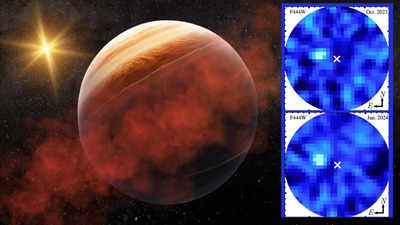
The James Webb Space Telescope (JWST) has accomplished a significant feat by capturing an image of AF Leporis b, an exoplanet that is located 88 light-years away from Earth. This planet holds a special distinction as the lowest-mass exoplanet ever directly observed by JWST. Moreover, it is also notable for being the closest planet to its parent star that JWST has successfully imaged.The success of this observation shows how JWST is pushing the boundaries of what can be studied in distant planetary systems.
Astronomers had to work quickly because the exoplanet AF Leporis b was moving closer to its parent star. As the planet approached its star, the star’s intense light would have eventually outshone the planet, making it unobservable for nearly a decade. This would happen because the bright light would interfere with the telescope’s ability to detect the planet. Luckily, astronomers managed to observe it before it was too late, capturing crucial data just before the planet began disappearing behind the glare of its star.
Record-breaking discovery: AF Leporis b becomes lowest-mass exoplanet detected by JWST
In 2023, AF Leporis b set multiple records:
- It became the lowest-mass exoplanet ever to be detected through direct imaging by JWST, with a mass 3.2 times that of Jupiter.
- Its mass was measured using a technique known as astrometry, which tracks the movements of stars. These movements are caused by the gravitational pull of orbiting planets, allowing astronomers to estimate the planet’s mass. This discovery represents a breakthrough in the ability to detect relatively low-mass planets through direct observation.
AF Leporis b’s youth and size make it an ideal target for JWST observation
AF Leporis b is considered a very young planet, being only 23 million years old. To put this in perspective, Earth is about 4.6 billion years old, making AF Lep b extremely youthful in astronomical terms. The fact that it is still in the early stages of its development makes it a valuable subject for study, as astronomers can learn more about the formation and evolution of planets.
Its large size and proximity to its star made it an ideal target for observation using JWST. These characteristics allowed the telescope to detect and study the planet more easily, despite the challenges posed by the star’s brightness.
JWST overcomes challenges of observing AF Leporis b near its bright parent star
One of the main challenges JWST faces when observing exoplanets is its long-wavelength sensitivity, which can make it difficult to distinguish between objects that are close together. In the case of AF Leporis b, the planet is located relatively close to its parent star, and the star’s brightness could have overshadowed the planet, making it difficult to capture clear images.
To overcome this challenge, JWST used a coronagraph, a device designed to block out most of the light from the star. This allowed the telescope to focus on the dimmer light coming from the planet, successfully capturing its image despite the difficulties posed by its proximity to the star.
AF Leporis b shows active atmosphere and faces observability challenges
The observations of AF Leporis b revealed that it has an active atmosphere, with convection currents transporting gases between its upper and lower layers. This suggests that the planet is undergoing dynamic atmospheric processes. Additionally, astronomers detected unexpectedly high levels of carbon monoxide in its atmosphere. These elevated levels of carbon monoxide could be the result of strong updrafts carrying gases from deeper within the planet’s atmosphere to the surface.
At the moment, AF Leporis b is located about eight times the distance between Earth and the Sun from its star. However, as it continues to move closer to its parent star, the increasing intensity of the star’s light will soon block JWST’s view of the planet. This means that the planet will become unobservable for about 10 years, until it re-emerges from behind the glare of its star and can be studied again with current technology.
JWST achievement paves the way for future discoveries in exoplanet research
This achievement by JWST not only highlights the telescope’s ability to make groundbreaking discoveries but also foreshadows the future of exoplanet research. The success of this observation opens the door for more detailed studies of newly discovered planets, providing valuable insights into their formation, atmospheres, and other key characteristics. With JWST’s advanced capabilities, the potential for further revolutionary discoveries in the field of exoplanet research is vast. The findings from this study have been published in the Astrophysical Journal, contributing to the growing body of knowledge about distant planetary systems.
Also Read | Prada’s new NASA spacesuit redefines Haute Couture in space exploration; first woman to wear this Prada spacesuit
